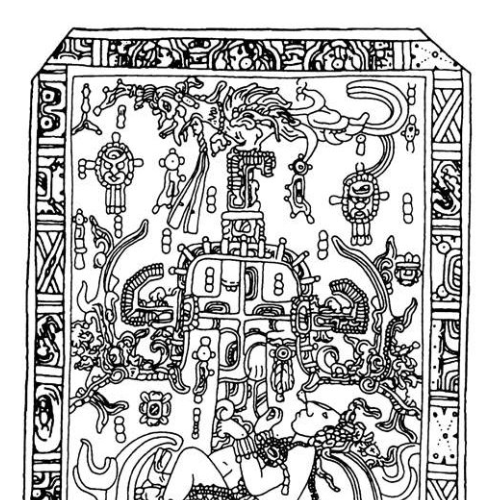Abstract
Since the discovery of the Palenque sarcophagus lid, there has been much speculation about the meaning of the various figures and shapes depicted on its carved surface. The author of this document focuses primarily on the small three-circled elements (“triplets”) scattered around the upper portion of the lid, and argues that those supposedly mere ornamental items are actually components of a sophisticated encoding procedure. This coding system consists of a geometrical and an interpretational part, where the former leads the decoder from an initial item arrangement to a final figure through a series of indicated transformations in a logically compelling way, while the latter apparently suggests to interpret this resulting shape and its enclosing context as a message about an interstellar space travel to the Earth that started from a binary solar system three times as far away from the Sun as the nearest star (i.e. the Proxima Centauri).
Contents
Notice
Please be aware that the author of these pages is not a professional (in fact not even a hobbyist) on the subjects of Maya culture or SETI. His approach to the problem is much more that of a computer programmer with a passion for comprehending and “breaking” various types of coding methods.
Also please keep in mind that this document is not a scientific publication, it has not been, for instance, peer-reviewed by professional scientists or published in any scientific journal.
Nonetheless, and even if (technically speaking) this document might be characterized as a pseudoscientific one, the author did put all his efforts into making the content and its presentation as objective and scientific as possible.
Credits
The solution was inspired partly by the works of Maurice Cotterell and Erich von Däniken. (For more information about the type of inspiration and the solution process please visit this page).
The depictions of the lid used throughout the document were created by Merle Greene Robertson and Maurice Cotterell.
The following tools provided indispensable help in creating these pages: NetBeans (HTML / Java), GIMP (image manipulation), Gifsicle (optimizing animated GIFs), FFmpeg (video converting) and Notepad++ (HTML editing and batch multiline search/replace).
License

The Palenque Code by
Akusius
is licensed under a
Creative Commons Attribution 4.0 International License.
The intention is that you may use any text, image or animation in the document for any purpose (even commercially), as long as you include a link or reference to this page.
You might also fork the repository behind these pages within GitHub, and build your own version of the document if you will.
Contact
If you would like to comment on a page or raise a question on a specific topic, you can use the integrated commenting system at the bottom of each page (please enable JavaScript for this function to work).
If you have any ideas or suggestions to the text (or anything else), please use the issue tracker to report it. Thank you!
If you would like to contact the author, you can send him an email to akusiushu@gmail.com, or you can find him on Twitter and GitHub.
Support
If you find this document and the solution (or the other theories) presented in it interesting, please consider donating a small amount to support its author. Thank you very much!
| Account number (Hungary) | 11773061-00343354 |
| Account number (IBAN) | HU62 1177 3061 0034 3354 0000 0000 |
| Financial institute | OTP Bank (SWIFT: OTPVHUHB) |
| Currency | HUF (1 US$ ≈ 300 HUF) |
| Account holder | Bujdosó Ákos |
